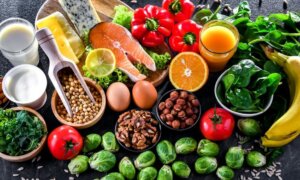To prevent osteoporosis, getting enough calcium is paramount. There is a golden period in one’s life to do that, and missing it will make it difficult to compensate even with enormous amounts of calcium intake later, according to Yvonne Cai, a nutritionist at Keyi Nutrition Consulting Center, who was recently interviewed on NTDTV’s “Health 1+1” program.
According to the American Academy of Orthopedic Surgeons, the human body attains its peak bone mass between the ages of 25 and 30; after that, bone mass begins to decline slowly, and after 50, the decline starts to accelerate. This is particularly the case for women, who will see a bone mass loss as high as 10 percent to 20 percent within the five or six years around menopause.
Bone mass is related to genetics, calcium intake, and exercise. Calcium deficiency will reduce bone density, making one more vulnerable to bone fractures or osteoporosis.
Cai suggested that people should start supplementing calcium early because the body’s prime period for accumulating calcium is from birth to adolescence. People should not wait until there are signs of osteoporosis before resorting to calcium supplementation. Once osteoporosis starts, it is difficult for older patients to increase bone density even if they consume substantial amounts of calcium.
Adolescents aged 13 to 18 should take in more calcium, needing about 1,300 milligrams daily; adults over 19 need about 1,000 milligrams of calcium daily. However, daily calcium intake should not exceed 2,500 milligrams.
To prevent bone loss and maintain healthy bones, besides supplementing with calcium and related nutrients such as vitamin D, Cai recommends increasing one’s physical activity and stimulating bone cell activation through exercise. For example, walking, jogging, weightlifting, etc., can help strengthen the bones.
5 Foods to Up Calcium Intake
A healthy diet rich in calcium should be sufficient to obtain the recommended daily intake amount.
1. Milk
Cai said milk is the best calcium supplement because of its high absorption rate. One cup of fresh milk can fulfill one-quarter of the daily calcium demand. Eating about 2 ounces of cheddar cheese or 8.5 ounces of plain, whole-fat yogurt daily can achieve the same amount of calcium intake.
As for the absorption rate, the calcium in milk is composed of calcium caseinate, calcium phosphate, and soluble calcium. Because of its relationship with casein, calcium can be released slowly in the intestines, increasing its absorption rate. This means the calcium absorption of milk can be as high as 35 percent.
The calcium in cheese exists primarily as calcium paracaseinate. As cheese is solid, its calcium content is released even more slowly in the intestines, helping increase its absorption there.
The calcium in beverages containing lactic acid, such as the fermented milk drink kefir, exists in the form of ionized calcium, and the absorption rate is slightly lower than that of milk. Because of its lower pH value, more of the calcium in lactic acid will be released into the solution in its vicinity. So after the calcium ions reach the intestines, calcium will be dispersed there, and some of the calcium will be lost and excreted with the feces.
2. Tofu
About 1 cup of soft tofu contains as much calcium as 1 cup of milk. It is a good calcium supplement for vegetarians or people who are lactose intolerant.
3. Kelp
Every 3.5 ounces of kelp contains 168 milligrams of calcium, with a calcium absorption rate of around 30 percent, considered the highest among vegetables. Kelp is low in calories and rich in iodine, magnesium, and dietary fiber, making it suitable for people watching their calories. Kelp can be used as a soup base or cold salad (e.g., seaweed salad).
4. Dried Silver Sprat
Dried silver sprat, or Japanese silver-stripe round herring, is a small calcium-rich fish. Every 0.35 ounce of dried silver sprat has as much calcium as 1 cup of milk. It is also rich in protein and unsaturated fatty acids. Eat it in moderation and beware of the salt content, which may lead to excessive sodium intake.
5. Black Sesame Seeds
Every roughly 1.5 tablespoons of black sesame seed has as much calcium as a cup of milk. It is also rich in omega-6 polyunsaturated fatty acids and trace minerals such as iron and magnesium. Black sesame seeds can be made into a paste or added to porridge, bread, or lattes to add flavor.
Calcium-Rich Vegetables
In addition to dairy products, vegetables, legumes, and grains are also valuable sources of calcium, especially for vegetarians.
Common calcium-rich vegetables are usually dark green vegetables and seaweed. Kale has the highest calcium content, with 254 milligrams per 3.5 ounces. Wakame follows, with 150 milligrams of calcium per 3.5 ounces. Other vegetables, such as asparagus, Chinese kale, broccoli, and amaranth, are also good sources of dietary calcium.
Cai pointed out that the absorption of calcium and other trace minerals is often affected by adverse nutritional factors such as oxalate and phytate. Vegetables with higher oxalate content, such as spinach, can drop calcium absorption to as low as 5 percent. In comparison, other vegetables with lower oxalate content, such as kale (49 percent absorption), broccoli (61 percent), Chinese mustard green (40 percent), bok choy (54 percent), etc., all have a higher calcium absorption rate.
6 Factors Affecting Calcium Absorption
The following are the main factors affecting how much calcium the body can absorb.
1. Oxalic Acid and Phytic Acid
Oxalic acid is a natural compound in many vegetables. It combines with calcium to form calcium oxalate, which reduces the absorption rate of calcium. High-oxalate vegetables include spinach and amaranth (an ancient grain). Whole grains, beans, and nuts have high phytic acid. It also combines with calcium to form a compound that is difficult to absorb, but it is not as bad as oxalic acid when it comes to reducing calcium absorption.
2. Excess Sodium
Both sodium and calcium are excreted through urine. When too much sodium is taken in, the kidneys will accelerate sodium excretion and increase calcium excretion simultaneously. In addition, excess sodium may interfere with calcium absorption by the intestines.
3. Excess Protein
The kidneys are responsible for disposing of ammonia and calcium ions after protein breakdown. If you consume too much protein, your kidneys will also excrete calcium from the blood while getting rid of ammonia.
Studies have found that when calcium and phosphorus intake remain constant, a twofold increase in protein will lead to a 50 percent increase in urinary calcium.
4. Excess Caffeine
Caffeine has a diuretic effect. Drinking more than
300 milligrams of caffeine per day (about three cups of black coffee) will cause the body to excrete water and calcium at the same time. This is particularly bad for older women postmenopause as it will accelerate the loss of spinal bone.
5. Insufficient Vitamin D
Vitamin D is also needed for adequate calcium absorption from food.
Vitamin D can increase calcium absorption in the small intestines, regulate calcium and phosphorus balance to promote bone health, and work synergistically with parathyroid hormone to maintain blood calcium balance and renal calcium reabsorption. When vitamin D is insufficient, calcium metabolism will be affected.
According to the recommendations of the Food and Nutrition Board (FNB) of the Institute of Medicine of the National Academies, people ages 1 to 70 should consume 600 international units (IUs) of vitamin D (D3) daily, increasing to 800 IU after 70. However, some evidence suggests the recommended amount should be higher.
In the United States, more and more foods are supplemented with calcium and vitamin D to make it easier for people to get enough of these nutrients from their diets.
6. Soft Drinks
Carbonated
soft drinks contain caffeine, phosphoric acid, sugar, and sodium, which will affect the absorption rate of calcium, increase calcium loss, lead to an imbalance in the calcium-phosphorus ratio, decrease bone density, and increase the risk of fractures.
















